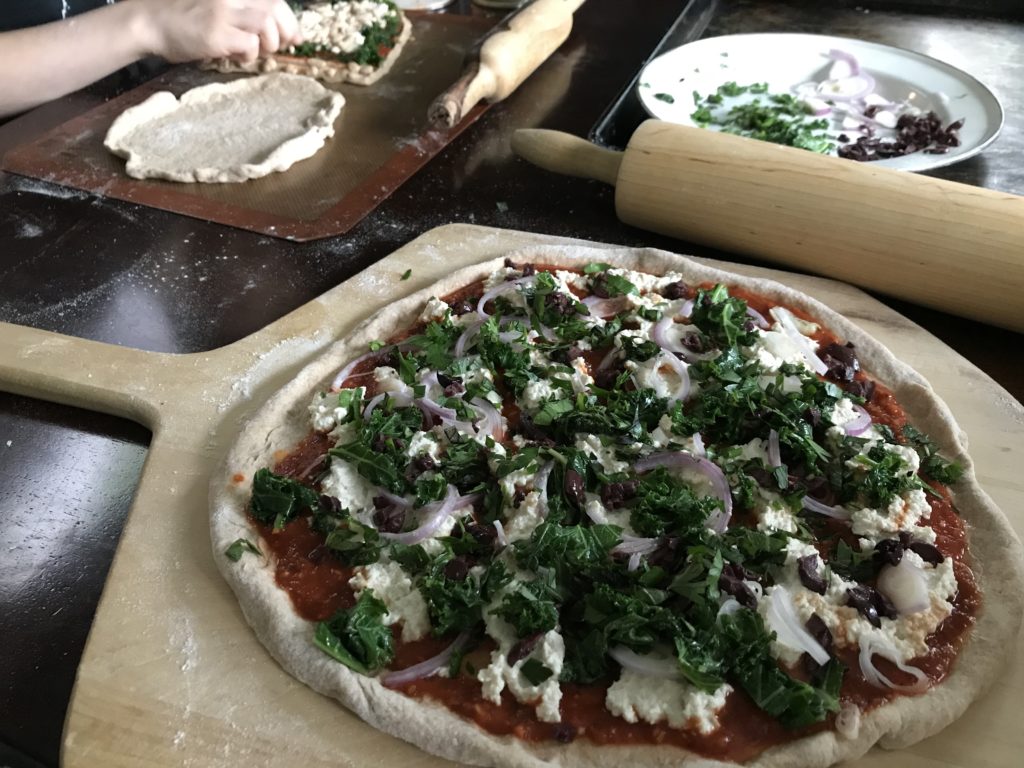When it’s time for a celebratory dinner – whether we’re marking a big milestone or just the end of another week at home – pizza is often my go-to meal choice. There’s something so comforting and nostalgic about it… though the pies I make now bear little resemblance to the pizzas of my childhood.

I’ve been vegan for many (many!!) years, and for a long time the perfect vegan pizza eluded me. In the early days, I’d often just have a traditional veggie pizza without the cheese. But that was never very satisfying, since it was basically just a thin slice of bread with red sauce and veggies on it.
Over the past few years, there has been an explosion of new plant-based food products. Now, you can buy vegan cheeses that melt just like the dairy-based versions, and fake meat products that stand in very convincingly for traditional meats. So, should be an easy switch, right?
Well… not so much (for me anyway). I’ve totally lost my taste for dairy by now, so most faux cheese products are not appetizing to me at all. And while these products are marvels of food science, most are highly processed and leave a lot to be desired in the nutrition department. (I do, however, love Field Roast’s smoked apple sage sausage, and it’s a frequent addition to our pizzas.)
Eventually, after a lot of tinkering, I started making a vegan “ricotta” to top our pizzas with. For us, this was the perfect solution: it made the pies much more satisfying, gave us that salty/creamy flavor we’d been missing, and a little boost of protein as well. It may not melt like dairy cheese, but that hasn’t ever been too much of a concern for us, because it just tastes so good.

On pizza night, we typically make two pizzas for us grown-ups: one with a traditional marinara sauce and one with a garlic & herb olive oil base. Meanwhile, the kids roll out and decorate their own personal pies. We’re notorious for forgetting to buy veggies specifically to use as pizza toppings, so often we’ll keep it simple based on what we have on hand.

Our red-sauce pizza usually includes sliced onions, Kalamata olives, red peppers or tomatoes, and something green, like fresh parsley or kale. The pizza with the olive oil base, on the other hand, will often have more adventurous/fancy toppings, such as:
- Sautéed kale, sliced shallots, and walnuts
- Roasted delicata squash, caramelized onions, and sage
- Bosc pears, chopped pistachios, and red onion

So, whether you’re avoiding dairy or just want to try a new spin on pizza, give these pies a try! Though they may be a tad more labor-intensive than the standard version, they are well worth the effort, and make a very satisfying meal (especially when paired with a salad or cooked greens). And if you have any other vegan pizza tips or topping suggestions, leave them in the comments below!
Delicious Vegan Pizza
Ingredients
Pizza Dough
- 1½ cups water, lukewarm
- 2¼ tsp yeast
- 3 cups all-purpose flour, whole wheat, white, or a 50/50 mixture
- 1 tsp salt
- 2 Tbsp olive oil
Garlic & Herb Olive Oil Base
- 1 clove garlic, crushed
- 3 Tbsp olive oil
- 1 tsp oregano, dried
- ⅛ tsp salt
Vegan Ricotta
- 1 package firm or extra-firm tofu, drained
- 1/3 cup cashews, raw, unsalted
- 2 TB lemon juice, or 1 TB apple cider vinegar
- 2 TB olive oil
- 1 clove garlic, chopped
- 1/2 tsp salt
Additional Toppings
- marinara or pizza sauce
- other toppings of your choice
Instructions
Make the Olive Oil Base
- Place the crushed garlic clove into a small bowl. Add the olive oil, oregano, and salt. Let sit for at least an hour (or, better, two!) so that the garlic and herbs have time to infuse the oil.
Make the Pizza Dough
- Mix the yeast into the lukewarm water, and let sit for a minute to give the yeast time to wake up.
- Add the salt, flour, and olive oil. Knead in a mixer using a dough hook, or by hand, for about five minutes. If the dough is too sticky, you may need to add a bit more flour.
- Cover and let rise for about an hour.
Make the Vegan Ricotta
- Break the tofu block in half. In a food processor or blender, mix together ½ of the tofu and all other ingredients (cashews, lemon juice, olive oil, garlic, and salt); blend until smooth.
- Crumble in remaining tofu and pulse a few times. The mixture should be slightly chunky, like ricotta.
- Adjust seasonings to taste (you may need to add a little extra lemon juice/vinegar and salt – you want it to have a strong briny zip).
- Refrigerate until ready to assemble pizza.
Assemble the Pizzas
- Preheat the oven to 450°F. This is a good time to prep your toppings – slice up fresh veggies and olives, and sauté hardy greens or sausage crumbles.
- Punch down the dough and divide into two pieces. Optional step: if you have family members who want to decorate their own smaller pie, pinch off a small amount (about the size of a clementine orange) from each dough half for them to roll out separately.
- Roll out one of the larger dough balls. Stir the olive oil mixture (the salt will have sunk to the bottom) and spread evenly on the pizza crust. You can chop the garlic clove into smaller pieces and sprinkle on top of the pizza for a little extra garlicky goodness. Add dollops of vegan ricotta so that the crust is mostly covered. Then add the rest of your toppings!
- Repeat with the other dough half, but use red sauce for the base (or double the olive oil base recipe and use it for both pies), and dollop with vegan ricotta. Sprinkle on your other toppings.
- Bake each pie on a pizza stone or baking sheet for about 15 minutes.
- Cut and serve!



